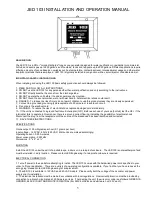
7.0 Batteries
WARNING!
Working with batteries is dangerous!
Batteries generate explosive gasses!
•
Therefore it is of out most importance that each time you serve equipment in the vicinity of the battery, to
follow the battery instructions very accurate. Never smoke or allow a spark or a flame in the vicinity of a
battery.
Lead acid batteries
• Lead acid batteries are the best choice for general applications; they are easy and uncomplicated to use
and their performance to price ratio is superior.
• The batteries are available in many different types, sizes, ampere hours (Ah), voltages and chemistries.
Lead acid battery types
•
Starting batteries -
These batteries are designed for high discharge in very short time (1~2 min.) and only
used for cranking purpose. Not recommended for inverter applications. They will not damage the inverter but
the problem is that these batteries will not last in deep cycle applications.
•
Deep-cycle batteries -
Recommended for the inverter applications. The deep-cycle batteries are designed
for applications where high discharge rate is needed. They can be discharged up to 80% of rated capacity
without being damaged.
Battery sizing
• The batteries are the inverters (combi) energy source. The larger the batteries are the longer the inverter
can operate before recharging is necessary.
• An undersized battery bank results in reduced battery life and disappointing system performance.
•
The leading cause of premature battery failure is improper charging and poor battery maintenance.
• Note: In general do not discharge the battery more than 50% of rated capacity. Discharging of 80% is
acceptable on a limited basis such as a prolonged utility outage. Total discharge of battery will result in
permanent damage and reduced battery life.
•
Note: Batteries discharged at a low rate will be able to deliver a higher capacity than those discharged at a
high rate
Estimating battery requirements (VOLT x AMPS = WATTS):
• The watt ratings of each appliance powered by inverter must be added together. Use the figures from the
nameplate label on the appliance.
•
MultiplytheneededAhwith2
toreachtherecommenbatterAhsizeThiswilthbattecycled
•
Multiply the Ah with 2
to reach the recommended battery Ah size. This will also allow the battery to be
cycled only 50% on a regular basis.
Total watt consumption (W) x Running time (Hours)
Needed battery capacity (Ah) =
Battery voltage (V) x 0,9 (Eff.)
Содержание 1012-50
Страница 2: ......
Страница 6: ...1 1 Mechanical Dimensions Model 1512 80 2012 100 2324 50 ...
Страница 7: ...1 2 Mechanical Dimensions Model 1012 50 1024 30 1312 80 1524 40 ...
Страница 24: ......




































